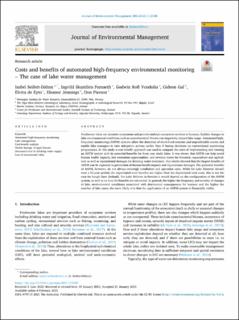| dc.contributor.author | Seifert-Dähnn, Isabel | |
| dc.contributor.author | Furuseth, Ingvild Skumlien | |
| dc.contributor.author | Vondolia, Godwin Kofi | |
| dc.contributor.author | Gal, Gideon | |
| dc.contributor.author | De Eyto, Elvira | |
| dc.contributor.author | Jennings, Eleanor | |
| dc.contributor.author | Pierson, Don | |
| dc.date.accessioned | 2021-07-16T09:48:31Z | |
| dc.date.available | 2021-07-16T09:48:31Z | |
| dc.date.created | 2021-02-26T14:02:56Z | |
| dc.date.issued | 2021 | |
| dc.identifier.citation | Journal of Environmental Management. 2021, 285, 002108. | en_US |
| dc.identifier.issn | 0301-4797 | |
| dc.identifier.uri | https://hdl.handle.net/11250/2764640 | |
| dc.description.abstract | Freshwater lakes are dynamic ecosystems and provide multiple ecosystem services to humans. Sudden changes in lake environmental conditions such as cyanobacterial blooms can negatively impact lake usage. Automated high-frequency monitoring (AHFM) systems allow the detection of short-lived extreme and unpredictable events and enable lake managers to take mitigation actions earlier than if basing decisions on conventional monitoring programmes. In this study a cost-benefit approach was used to compare the costs of implementing and running an AHFM system with its potential benefits for three case study lakes. It was shown that AHFM can help avoid human health impacts, lost recreation opportunities, and revenue losses for livestock, aquaculture and agriculture as well as reputational damages for drinking water treatment. Our results showed that the largest benefits of AHFM can be expected in prevention of human health impacts and reputational damages. The potential benefits of AHFM, however, do not always outweigh installation and operation costs. While for Lake Kinneret (Israel) over a 10-year period, the depreciated total benefits are higher than the depreciated total costs, this is not the case for Lough Gara (Ireland). For Lake Mälaren in Sweden it would depend on the configuration of the AHFM system, as well as on how the benefits are calculated. In general, the higher the frequency and severity of changes in lake environmental conditions associated with detrimental consequences for humans and the higher the number of lake users, the more likely it is that the application of an AHFM system is financially viable. | en_US |
| dc.language.iso | eng | en_US |
| dc.publisher | Elsevier | en_US |
| dc.rights | Navngivelse 4.0 Internasjonal | * |
| dc.rights.uri | http://creativecommons.org/licenses/by/4.0/deed.no | * |
| dc.title | Costs and benefits of automated high-frequency environmental monitoring – The case of lake water management | en_US |
| dc.type | Peer reviewed | en_US |
| dc.type | Journal article | en_US |
| dc.description.version | publishedVersion | en_US |
| dc.rights.holder | © 2021 The Author(s). P | en_US |
| dc.source.volume | 285 | en_US |
| dc.source.journal | Journal of Environmental Management | en_US |
| dc.identifier.doi | 10.1016/j.jenvman.2021.112108 | |
| dc.identifier.cristin | 1894066 | |
| cristin.ispublished | true | |
| cristin.fulltext | original | |
| cristin.qualitycode | 1 | |

